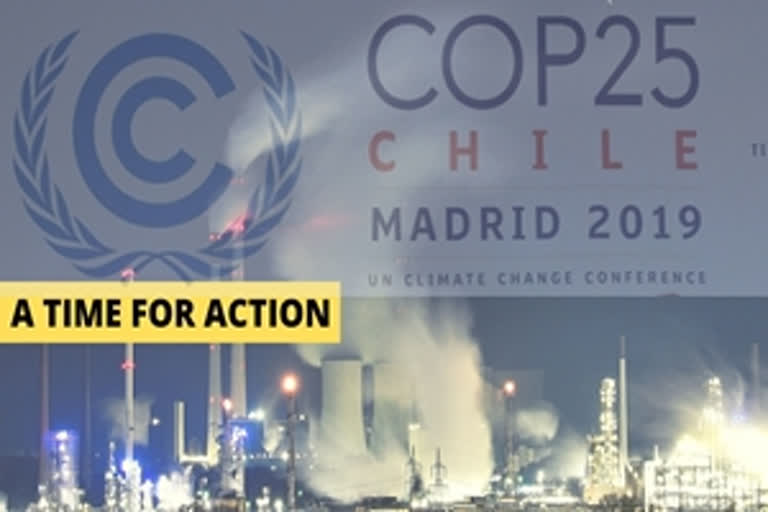Hyderabad:Changes in atmosphere leading to dangerous repercussions indicate that the world is going to face a big challenge. Conference Of Parties (COP) 25 held four years ago in 2015 aims to confine global warming at 1.5 degrees Celsius by this century end. It was the target of all worldly nations which are mulling options now to implement the Paris Agreement. This conference was held for 12 days from December 2 to 13 in Madrid of Spain. The spirit of Paris pact was punctured as there was no breakthrough in the conference on key issues.
On average, 1.5 per cent of Greenhouse gas emissions were released a year for the past 10 years. Also, about 55.3 gigatons of carbon monoxide were released in recent years adding to global warming. This was reported by UNO which warns and reflects future danger. Before the start of COP 25 conference, UNO stressed the need for an action plan implementation to check global warming by 195 member nations.
In the discussions, differences cropped up among developing and developed nations leading to a stalemate. Inaugurating the conference, UN Secretary-General asked member nations to have national determination and cooperation (NDC) to expedite steps by next year to implement the action plan to reach targets of environmental programs. He also exhorted to neutralise carbon emissions by 2050 which stresses the need for efforts to check global warming. Fact is that world nations will fail to reach targets by 2030 if the present rise in global warming ratio continues unabated. Global Warming intensifies rise in global temperatures by 1.1 per cent on earth leading to natural calamities causing huge loss to lives and assets. These repercussions show adverse effects on the economic systems of developing countries.
The unavoidable target for the world nations is to reduce carbon emissions by 7.6 per cent every year from 2020 to 2030. Matter of concern is that warnings of global temperatures may rise to 3.2 degrees Celsius by 2100 if no steps taken to reach targets. Across the world, now 78 per cent greenhouse gas emissions are brought reported from -- US, Canada, Australia, Russia, Japan, Korea, China, India, Mexico, South Africa, Indonesia, Brazil, Argentina and some on EU nations. It is evident of non-starter and negligence on part of wealthy nations as seven of G-20 nations are yet to begin steps to check carbon emissions.
Due to the lack of a strategy to reach Paris Agreement targets before 2020, confusion prevails on action plan post-2020 conference to check carbon emissions and global warming. Occupying the second place in the list of the nations mostly contributing to carbon emissions (15 per cent) the US announced to quit Paris pact which reflects the stance of wealthy nations come clear on the key global issue.
Significantly, China which adds mostly to the problem with 28 per cent carbon emissions has failed to amend its targets to check the problem. Member nations are indulging in a tussle on Article 6 of the Paris Agreement that aims to control global warming. From the Kyoto Protocol to the recent Paris agreement, no further steps being taken to reach targets such as controlling carbon emissions and count related standard units (CER) as part of clean development mechanism (CDM) due to differences among the member counties.
In developing countries, as per the clean development mechanism, controlling one ton of carbon gas emissions is counted as one 'credit'. Also, there is an arrangement for the sale and purchase of such 'credits'. Industrially developed nations make use of such registered credits for controlling Carbon emissions for sustainable development.
Since this will pave way for checking carbon emissions problem, credit the system was reportedly included in the Kyoto protocol. Discontent crops up as no final call was taken with regard to the countries that achieved standard units to control carbon emissions before the time phase of 2020. Thus, it stresses the need for clarity on Article 6 of the Paris agreement.
